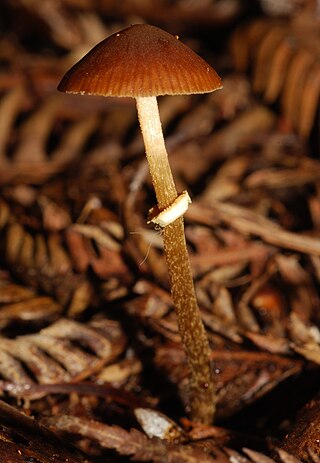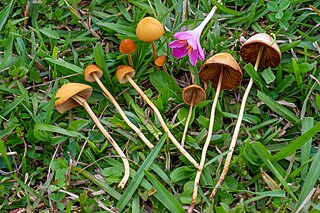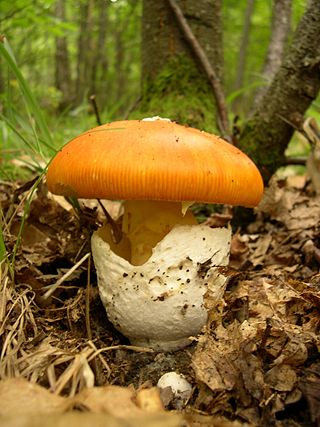
Baeocystin is a zwitterionic alkaloid and analog of psilocybin. It is found as a minor compound in most psilocybin mushrooms together with psilocybin, norbaeocystin, aeruginascin, and psilocin. Baeocystin is an N-demethylated derivative of psilocybin, and a phosphorylated derivative of 4-HO-NMT (4-hydroxy-N-methyltryptamine). The structures at right illustrate baeocystin in its zwitterionic form.
Caridad Bravo Adams was a prolific Mexican writer and the most famous telenovela writer worldwide.

Conocybe is a genus of mushrooms with Conocybe tenera as the type species and at least 243 other species. There are at least 50 different species in North America.

Conocybe rugosa is a common species of mushroom that is widely distributed and especially common in the Pacific Northwest of the United States. It grows in woodchips, flowerbeds and compost. It has been found in Europe, Asia and North America. It contains the same mycotoxins as the death cap mushroom. Conocybe rugosa was originally described in the genus Pholiotina, and its morphology and a 2013 molecular phylogenetics study supported its continued classification there.

Conocybe tenera, commonly known as the brown dunce cap or common cone head, is a widely distributed member of the genus Conocybe. This mushroom is the type species for the genus Conocybe.

Pholiotina cyanopus is a species of fungus that contains psychoactive compounds including psilocybin and the uncommon aeruginascin. Originally described as Galerula cyanopus by American mycologist George Francis Atkinson in 1918. It was transferred to Conocybe by Robert Kühner in 1935 before being transferred to Pholiotina by Rolf Singer in 1950. A 2013 molecular phylogenetics study found it to belong to a group of species currently assigned to Pholiotina that are more closely related to Galerella nigeriensis than to Pholiotina or Conocybe. It is likely that it will be moved to a different genus in the future, but this has not happened yet.
La Intrusa is a Venezuelan telenovela produced by Radio Caracas Televisión in 1986. Based on a story written by Inés Rodena, it is a remake of the 1971 telenovela La usurpadora which starred Marina Baura and Raul Amundaray with the new version being written by Ana Mercedes Escámez, Benilde Ávila and Zaret Romero.

A Intrusa is a 1979 Brazilian drama film directed by Carlos Hugo Christensen, based on the short story "La intrusa" by Jorge Luis Borges. The film is about the parallel lives of two gaucho brothers with Danish ancestry. It was shot in Uruguaiana, Rio Grande do Sul.

Conocybe apala is a basidiomycete fungus and a member of the genus Conocybe. It is a fairly common fungus, both in North America and Europe, found growing among short green grass. Until recently, the species was also commonly called Conocybe lactea or Conocybe albipes and is colloquially known as the white dunce cap or the milky conecap. Another common synonym, Bolbitius albipes G.H. Otth 1871, places the fungus in the genus Bolbitius.

In mycology, a volva is a cup-like structure at the base of a mushroom that is a remnant of the universal veil, or the remains of the peridium that encloses the immature fruit bodies of gasteroid fungi. This macrofeature is important in wild mushroom identification because it is an easily observed, taxonomically significant feature that frequently signifies a member of Amanitaceae. This has particular importance due to the disproportionately high number of deadly poisonous species contained within that family.

Pholiotina is a genus of small agaric fungi. It was circumscribed by Swiss mycologist Victor Fayod in 1889 for Conocybe-like species with partial veils. The genus has since been expanded to include species lacking partial veils.

Conocybe rickenii is a mushroom from the genus Conocybe. Its edibility is disputed, and it has the appearance of a typical little brown mushroom with a small, conical cap, and long, thin stem. In colour, it is generally a cream-brown, lighter on the stem, and it has a thin layer of flesh with no distinct smell or taste. It is a coprophilous fungus, feeding off dung and it is most common on very rich soil or growing directly from dung. It can be found in Europe, Australia and Pacific islands.

Coprophilous fungi are a type of saprobic fungi that grow on animal dung. The hardy spores of coprophilous species are unwittingly consumed by herbivores from vegetation, and are excreted along with the plant matter. The fungi then flourish in the feces, before releasing their spores to the surrounding area.
Conocybe siligineoides, also known as cone caps, Ya'nte, Ta'a'ya, or Tamu, is a species of macro-fungus in the family Bolbitiaceae. It has seldom been observed by the mycological community with all specimens having been collected in Mexico. Originally reported as a sacred mushroom, no chemical studies have been undertaken on this species although other members of the same genus have been shown to contain psilocybin, which causes strong hallucinations. They are crushed, dried, and used in tea, and consumed fresh.
La intrusa is a Mexican telenovela produced by Televisa for Telesistema Mexicano in 1964.
Ha llegado una intrusa is a Mexican telenovela produced by Valentín Pimstein for Canal de las Estrellas in 1974. Jacqueline Andere and Joaquín Cordero star as the protagonists, while Silvia Pasquel and Virginia Gutiérrez star as the antagonists.
Conocybe moseri is a mushroom species in the family Bolbitiaceae. It was described as new to science in 1980 by mycologist Roy Watling, from collections made in France. The specific epithet moseri honours Austrian mycologist Meinhard Moser. The fungus has been reported from the United Kingdom, growing in grassy areas, fields, and edges of woods. In 1995, it was recorded from Switzerland, from Ukraine in 2007, and from Russia in 2007. It was reported from India in 2015, where it was found growing on cattle dung.
Conocybe velutipes is a species of mushroom in the Bolbitiaceae family. It contains the psychedelic alkaloids psilocybin and psilocin.










